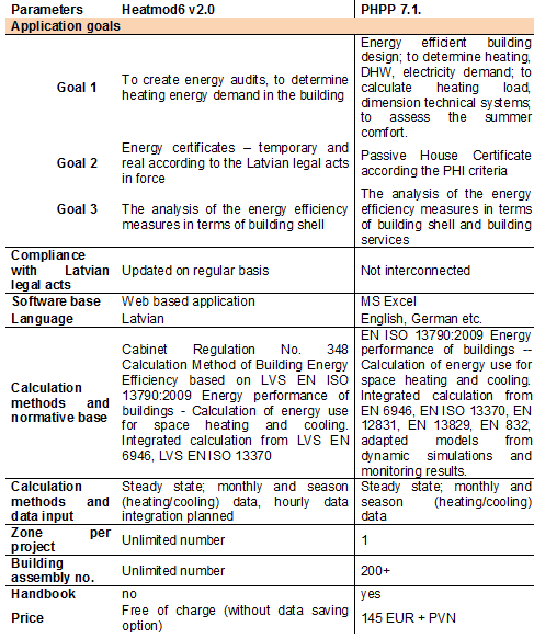Passive House planning package, PHPP in Latvia
PHPP comparison with Heatmod6 v2.0
Legislation concerning energy certification of buildings in Latvia
Law on Energy Performance of Buildings (from 9 January 2013) was adopted by the Parliament of the Republic of Latvia, based on the requirements set forth by Directive 2010/31/EU regarding energy certification of buildings and “nearly zero-energy buildings”; its aim is to facilitate rational use of energy sources by improving energy efficiency of buildings, as well as to inform the general public about energy consumption of buildings.
Legal acts issued basing on the Law on Energy Performance of Buildings:
• [Regulation No. 383 Regulations regarding Energy Certification of Buildings] (Riga, 9 July 2013 (minutes No. 39, § 39)), which stipulates the classification system for energy certification of buildings and requirements for nearly zero-energy buildings:
• Cabinet Regulation No. 348 Calculation Method of Building Energy Efficiency (Riga, 25 June 2013 (minutes No. 36, § 27)) sets forth a method for calculating energy efficiency of building, which is used for drafting balance at the building level, and determines the engineering systems to be included in the appraisal of building energy efficiency, as well as limits and types of appraisal.
Available tools - HeatMod6 and PHPP
Creating energy certificates is required by Building Energy Efficiency Law in Latvia. There are several calculation tools available to fulfil this requirement.
There is one official web-based tool (HeatMod6) which was developed by Center of Processes´ Analysis and Research, Ltd. under University of Latvia Faculty of Mathematics and Physics with a support from European Regional Development Fund to meet the demand for energy efficiency calculations and energy certification software. HeatMod is software for the calculation of the buildings’ heat balance by the mathematical modelling according to EN DIN 4108-6 and LBN 002-01. It allows for seasonal analysis of heat sources and losses of buildings. Software is being applied for the optimum design of heating systems and comparative analysis of project solutions in the accordance to normative requirements. In the last version calculation of heterogeneous layers and its visualisation is added. (source: http://www.paic.lv/en/produkti.php)
The other tool to use for energy efficiency calculations is Passive House Planning Package (PHPP). It is the key design tool used when planning a Passive House and as such, serves as the basis of verification for the Passive House Standard. Based on the large part on European norms, the PHPP makes use of numerous tested and approved calculations to yield a building’s the heating, cooling and primary energy demand, as well as its tendency to overheat in the warmer months. While the PHPP was developed specifically for Passive Houses, it is a design tool that may also be used for other buildings, including retrofits of historical buildings. (source: http://www.passivehouse-international.org/index.php?page_id=188)
Comparison
Both tools are based on the same EN ISO 13790:2009 standard for cooling and heating demand calculation, thus fulfilling the requirement stated in the Latvian regulation. When it comes to passive house standard and close to passive house standard building a high precision is required of the energy balance calculations to achieve the best results and to determine the values that can prove themselves in monitoring. PHPP has proven itself to be very precise and reliable software for this purpose. LEIF goal under the PassREg project task was to adapt PHPP for Latvian regulation so that it could also be officially used for the creating of energy certificates.
The differences and similarities of HeatMod6 v. 2.0 and PHPP 7.1 where discussed in a workshop held by Industrial Energy Efficiency Cluster. More than 20 experts and energy auditors where present in this event. It was concluded, that the main similarities that help PHPP to be adapted to the national legislation and used for energy certification are the calculations based on EN ISO 13790:2009 standard for cooling and heating demand and integrated calculations from EN 6946, EN ISO 13370.(See table below)
Conclusions
The main differences and challenges for adapting PHPP for national legislation turned out to be following:
- the Latvian regulations undergo frequent changes and adjustments are needed; - in case PHPP is used translation to Latvian is needed, but it is challenging due to the frequent new version issues of this software; - there are different approaches to DHW calculation. - PHPP license has a few, but HeatMod6 is free of charge.
Currently, there are about 50 PHPP users in Latvia, but this number is growing. Many energy auditors are using PHPP as a tool for energy balance calculation and Passive House planning and optimization. Energy auditors who use PHPP have no doubt that it is the best available static calculation tool for energy efficient buildings. A lot of them have attached their own spread sheets to PHPP in order to implement the needed Latvian regulations for energy passports. We are cooperating with them in the process of making suggestions for the Ministry of Economics to make these attachments to PHPP official. The source of financing for programming is the current issue, thus no date can be set for accomplishing the task to make PHPP as one of the official tools for energy certificate issuing. Nevertheless, the awareness about PHPP as energy balance calculation tool has grown during the PassREg project time, partially as a result of the mentioned activities.
More information: http://www.heatmod.lv/ http://www.passivehouse-international.org/index.php?page_id=188
